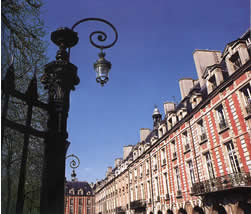

The
Place des Vosges, the oldest
square in Paris is one of the most
beautiful squares in the world.
Its history goes back to 1604 when
King Henri IV built a Royal pavilion
at the southern end of the square. The building was designed by
Baptiste
du Cerceau.
The King ordered all 35 other
buildings bordering the square to follow
the same design. The result, an early example of urban planning, is a
symmetrical square surrounded by buildings with red brick and white
stone facades, steep slate roofs and dorm windows, all constructed over
arcades.
The Royal pavilion at the center of
the southern side, the so-called
King's pavilion was built on top of a gateway. At the northern side
mirroring the King's pavilion is the Queen's pavilion.
Before the 17th century,
another prominent building occupied the
northern end of the square: the 'Hôtel de Tournelles'. This grand
building was constructed in 1388 and served as a residence for the
Royal family until 1559, when King Henri II was severely wounded during
a tournament held at the site. He died ten days later in the
Hôtel de Tournelles. His wife, Catherine de Medicis, had the
building demolished and moved to the Louvre.
The square was officially inaugurated
in 1612 as the 'Place Royale'. At
that time merely a lawn, it was a favorite place for duels. In 1639
Richelieu had an equestrian statue of King Louis XIII erected at the
center of the square. It was destroyed during the French Revolution but
a new statue of King Louis XIII was installed in 1825.
In 1800 Napoleon changed the name of
the square from 'Place Royale' to
'Place des Vosges' to show his gratitude towards the Vosges department,
the
first department in France to pay taxes. It was again renamed Place
Royale
in 1815, only to be changed yet again into 'Place des Vosges' in 1870.
Many famous Frenchmen lived here,
among them Richelieu and Victor Hugo.
Cardinal Richelieu, who became prime minister of France in 1624 lived
at
nr 21 from 1615 to 1627. Victor Hugo, author of 'The hunchback of Notre
Dame' lived on the second floor of house n° 6, the 'Hôtel de
Rohan-Guéménée', from 1832 to 1848. The house, now
called 'Maison de Victor Hugo' is turned into a museum. You can visit
the rooms where Victor Hugo wrote most of 'Les Misérables'. On
display are souvenirs, drawings and books, all in chronological order,
from his childhood to his exile between 1852 and 1870.
The Place des Vosges is now a peaceful
place, a nice central park
surrounded by arcades with shops and cafes. It is located in the
historical Marais district, in the 3rd arrondissement, not far from the
Place de la Bastille.

